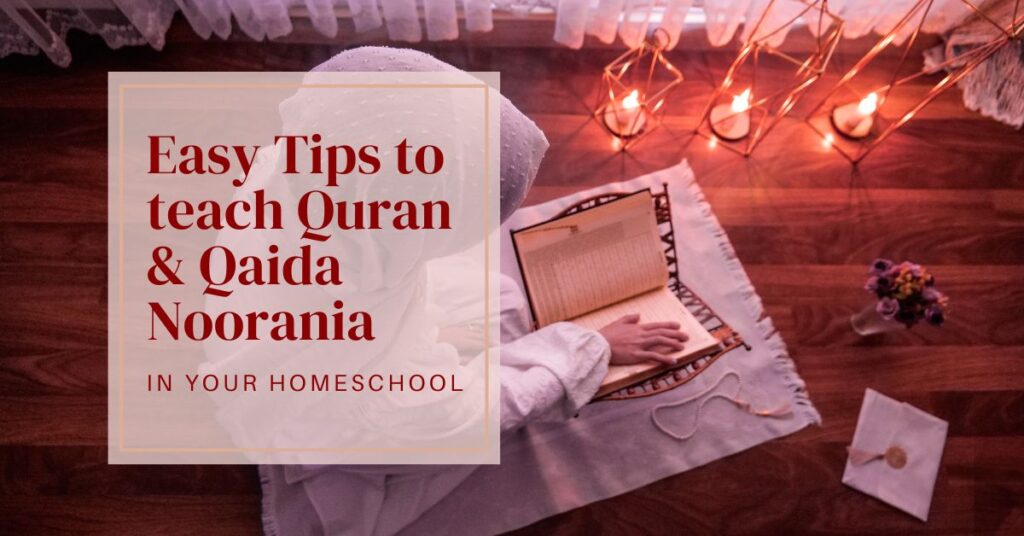Are you a muslim mom who is confused and overwhelmed on teaching the Quran to your child in your homeschool and you don’t know where to start?
Feeling overwhelmed about how to teach Quran at home and how to include Quran learning in your homeschool? You’re not alone…and I’ve been there too.
As a Muslim homeschooling mom, one of the most beautiful investments you can make is teaching your children to love, recite, and eventually read the Quran. And the good news? You can start at just 2 years old..even if you’re new to homeschooling or your child doesn’t know any Arabic yet.
In this post, I’ll walk you through the exact framework I use to teach each of my children the Quran from a young age using a simple, gentle, and consistent routine at home.
DISCLAIMER: This blog post contains affiliate links, which means if you make a purchase after clicking these links, I could earn a commission at no extra cost to you. I only recommend products, curriculums and resources I have used myself to help me homeschool with joy and stay on top of caring for my home.Thank you for your support.
When to start teaching the Quran to kids
You can start exposing your child to the Quran as early as 2 years old through listening to the Quran consistently. Then at 3 years old, you start teaching the arabic letters and sounds. And then at 4 years old, I recommend starting to help your child memorize the short surahs in the Quran. The key to learning Quran is starting young as this will build a habit in your kids to get used to the Quran study and always prioritize the Quran in their life.
Why Quran Education Matters
In your Muslim homeschool, teaching Quran and Qaida Noorania are not just another subject. They are your legacy. As long as your intention is renewed, this can also be a reward of sadaqah jariyah for you, in sha allah. This is the most rewarding time investment you’ll make, and it can be easy and enjoyable..even with toddlers!
The key is consistency, age-appropriate methods, and keeping it light and engaging. Teaching Quran can be fun using my framework that I’ll be teaching you.
My Framework to Teaching the Quran from Age 2+
Step 1: Quran Exposure at Age 2 — Let Them Listen
At this age, children are sponges. You don’t need formal lessons yet..just consistent exposure to listening to the Quran.
What to do:
- Play the Quran in the background during playtime (on TV, phone, or speaker).
- Let them absorb the sound of the Quran.
- Set a daily reminder or timer to turn on the Quran during playtime in your homeschool.
Why this works:
- Builds early recognition of the Quran sound.
- Creates positive and emotional connections to the Quran.
- Starts the journey with gentleness and joy and connects it with the Quran
Tip: Even a few minutes of daily listening helps plant the seeds of love for the Quran
Step 2: Teach Arabic Letters Through Play (Age 3)
When your child turns 3, start introducing the Arabic alphabet through simple, engaging activities. At this age you want to teach each arabic letter and sounds through games. First review all the letters with them. Once they have the letters memorized, then starting playing games with them to solidify the memory even more.
Through games, your child will pick up and memorize the letters very fast and retain in in their memory.
How to teach Arabic letters:
- Use Arabic alphabet magnets, flashcards, or wooden toys.
- Play matching games, scavenger hunts, or letter bingo.
- Teach letters out of order to ensure real recognition (not memorization of a sequence).
Examples:
- Hide an Arabic letter in the house and let them find it.
- Stick letters on a board or wall and have them hit the letter you say.
- Take turns being the teacher; you say the letters and your child finds it and then your child is the teacher and they say the letters and you find it.
Tip: Focus on letter shape and sound recognition. Keep each session short and fun—around 10–15 minutes per day.
Step 3: Formal Quran and Qaida Lessons (Ages 4–5)
At age 4 or 5, your child is ready for structured learning. This is when you start:
- Qaida Noorania lessons (closest book to the one I use)
- Quran memorization of short surahs (like Surah Al-Fatiha, Al-Ikhlas, etc.).
These are the only 2 subjects I focus on teaching at this age. I don’t teach reading or writing. I first start with the Quran and I help my child memorize their surah. Then we do 15 min of Qaidah lesson. Use a timer to let your child know that they just have to focus for that time then they are done their homeschool lesson. The key and the most important thing at this age is being consistent in doing their Quran lesson and Qaidah lesson everyday with them. With consistency you will see progress in your children.
Step 4: Prioritizing Quran in Homeschool Schedule (Ages 6+)
As children grow older and advance to grade school, integrate Quran memorization and arabic reading lessons with their core academic subjects.
As they get older and they finish the Qaida Noorania, hire a teacher for them, so they consistently practice reading the Quran with correct tajweed rules.
Also, schedule the Quran reading everyday in their homeschool schedule and keep it a priority in their day.
This age marks the transition to more structured bookwork while continuing the practice of Quran memorization and reading. Encourage children to view the Quran as a pillar of their homeschooling experience, emphasizing its significance as a daily practice to strenghten connection and love for the Quran.
Conclusion: Embracing the Quran as a Cornerstone of Homeschooling
Incorporating and prioritizing the Quran in your homeschool curriculum not only empowers children with Islamic knowledge but also instills a lifelong connection to the Quran. By following a structured framework and prioritizing the Quran and how to read the Quran helps you create a nurturing educational environment where children develop a deep love and understanding of the Quran.
Are you considering prioritizing the Quran in your homeschool? Share your thoughts and experiences in the comments below.


Pingback: 3 Free Islamic Homeschool Curriculums -
Pingback: Muslim Homeschool Kindergarten Curriculums Picks 2025/2026 -